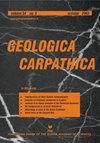斯洛伐克新布格重力异常图的地质构造解释
IF 1.5
4区 地球科学
Q4 GEOSCIENCES, MULTIDISCIPLINARY
引用次数: 0
摘要
本文分析了斯洛伐克最新的完整布格重力异常图与地质构造的关系。观测到的重力场包括区域和局部重力异常,以及明显的水平重力梯度。这张地图上最显著的区域特征是斯洛伐克中部北部的大面积低密度块(所谓的西喀尔巴阡重力低压),它被分为两个重力次低压:外喀尔巴阡重力低压和内喀尔巴阡重力低压。第一个次低压的来源为喀尔巴阡山脉外西复理石组的沉积物,第二个次低压的来源为花岗岩和正长石为主的地壳。有人认为,这片田野只是原始田野的躯干,它沿着斯洛伐克从西南到东北的整个长度延伸。然而,在构造发展的最年轻阶段,西斯洛伐克和东斯洛伐克境内的负重力异常场由于受到地幔软石器时代块体的影响而使岩石圈和地壳变薄而变为正重力异常场。斯洛伐克中部喀尔巴阡山脉以南的高密度岩体不仅仅是由软石器时代的作用造成的。与北方低密度花岗化杂岩相比,以变质杂岩为主、平均密度较高的不同构造段也是其表现的重要原因。这两个板块在斯洛伐克中部的边界是一个线状的尖锐构造带,与广泛的pohorel本文章由计算机程序翻译,如有差异,请以英文原文为准。
Geological and tectonic interpretation of new Bouguer gravity anomaly map of Slovakia
: This paper analyzes the latest complete Bouguer gravity anomaly map of Slovakia in relation to geological architecture. The observed gravity field consists of regional and local gravity anomalies, as well as marked horizontal gravity gradients. The most remarkable regional feature on this map is the large field with low-density masses in the northern part of Central Slovakia (the so-called Western Carpathian gravity low), which is divided into two gravity sub-lows: the Outer and Inner Western Carpathian gravity low. The source of the first sub-low is the sediments of the Outer Western Carpathian flysch units, and the second one is a crust with prevailing granites and orthogneisses. It is suggested that this field is only the torso of the original one, which stretched along the entire length of Slovakia from the SW to the NE. However, in the youngest stages of tectonic development, the negative gravity anomalous field in the territory of West and East Slovakia changed to a positive one due to the thinning of the lithosphere and crust by the influence of asthenolithic masses from the mantle. The higher density masses in Central Slovakia south of the Carpathian gravity low are not caused only by asthenolithic action. The different tectonic segment with a predominance of metamorphic complexes and a higher average density, in comparison to the low-density granitized complexes in the north, also contributes to its manifestation. The boundary between these two segments in Central Slovakia is a linear and sharp tectonic zone and coincides with the extensive Pohorelá shear zone. Several local anomalies also occur on the complete Bouguer anomaly map, and they were also subjected to geological analysis. These include local areas with a predominance of heavier crust, such as the core mountains in western Slovakia, subvolcanic intrusions, metabasic complexes, and the Cadomian basements. Prominent horizontal gravity gradients reflect the tectonic interfaces (faults, shear zones) that originated mainly during the youngest period of the Western Carpathian tectonic development and were also interpreted. The faults shown in the complete Bouguer anomaly map were active mainly during the transpressional and extensional stage of the Neo-Alpine tectonic development.
求助全文
通过发布文献求助,成功后即可免费获取论文全文。
去求助
来源期刊

Geologica Carpathica
地学-地球科学综合
CiteScore
2.40
自引率
23.10%
发文量
26
审稿时长
>12 weeks
期刊介绍:
GEOLOGICA CARPATHICA covers a wide spectrum of geological disciplines including geodynamics, tectonics and structural geology, volcanology, stratigraphy, geochronology and isotopic geology, karstology, geochemistry, mineralogy, petrology, lithology and sedimentology, paleogeography, paleoecology, paleobiology and paleontology, paleomagnetism, magnetostratigraphy and other branches of applied geophysics, economic and environmental geology, experimental and theoretical geoscientific studies. Geologica Carpathica , with its 60 year old tradition, presents high-quality research papers devoted to all aspects not only of the Alpine-Carpathian-Balkanian geoscience but also with adjacent regions originated from the Mediterranean Tethys and its continental foreland. Geologica Carpathica is an Official Journal of the Carpathian-Balkan Geological Association.
 求助内容:
求助内容: 应助结果提醒方式:
应助结果提醒方式:


